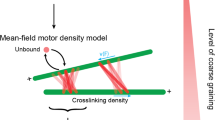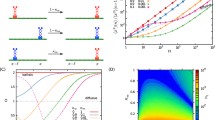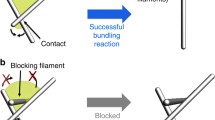Abstract
One of the most important issues of molecular biophysics is the complex and multifunctional behavior of the cell's cytoskeleton. Interiors of living cells are structurally organized by the cytoskeleton networks of filamentous protein polymers: microtubules, actin and intermediate filaments with motor proteins providing force and directionality needed for transport processes. Microtubules (MT's) take active part in material transport within the cell, constitute the most rigid elements of the cell and hence found many uses in cell motility (e.g. flagella andcilia). At present there is, however, no quantitatively predictable explanation of how these important phenomena are orchestrated at a molecular level. Moreover, microtubules have been demonstrated to self-organize leading to pattern formation. We discuss here several models which attempt to shed light on the assembly of microtubules and their interactions with motor proteins. Subsequently, an overview of actin filaments and their properties isgiven with particular emphasis on actin assembly processes. The lengths of actin filaments have been reported that were formed by spontaneous polymerization of highly purified actin monomers after labeling with rhodamine-phalloidin. The length distributions are exponential with a mean of about 7 μm. This length is independent of the initial concentration of actin monomer, an observation inconsistent with a simple nucleation-elongation mechanism. However, with the addition of physically reasonable rates of filament annealing and fragmenting, a nucleation-elongation mechanism can reproduce the observed average length of filaments in two types of experiments: (1) filaments formed from a wide range of highly purified actin monomer concentrations, and (2) filaments formed from 24 mM actin over a range of CapZ concentrations. In the final part of the paper we briefly review the stochastic models used to describe the motion of motor proteins on protein filaments. The vast majority of these models are based on ratchet potentials with the presence of thermal noise and forcing due to ATP binding and a subsequent hydrolysis. Many outstanding questions remain to be quantitatively addressed on a molecular level in order to explain the structure-to-function relationship for the key elements of the cytoskeleton discussed in this review.
Similar content being viewed by others
References
Alberts, B., Bray, D., Lewis, J., Raff, M., Roberts, K. and Watson, J.D.: Molecular Biology of the Cell, Garland Publishing, London, 1994.
Luby-Phelps, K.: Physical Properties of Cytoplasm, Curr. Opin. Cell Biol. 6 (1994), 3-9.
Hinner, B., Tempel, M., Sackmann, E., Kroy, K. and Frey, E.: Entanglement, Elasticity and Viscous Relaxation of Actin Solutions, Phys. Rev. Lett. 81 (1998), 2614-2618.
Frey, E., Kroy, K. and Wilhelm, J.: Viscoelasticity of Biopolymer Networks, Adv. Struct. Biol. 5 (1998), 135-168.
Ingber, D.E.: Tensegrity: The Architectural Basis of Cellular Mechanotransduction, Ann. Rev. Physiology 59 (1997), 575-599.
Chen, C.S., Mrksich, M., Huang, S., Whitesides, G.M. and Ingber, D.E.: Geometric Control of Cell Life and Death, Science 276 (1997), 1425-1428.
King, R.W.P. and Wu, T.T.: Electric Field Induced in Cells in the Human Body when This is Exposed to Low-Frequency Electric Fields, Phys. Rev. E 58 (1998), 2363-2369.
Ledbetter, M.C. and Porter, K.R.: A 'Microtubule' in Plant Cell Fine Structure, J. Cell Biol. 19 (1963), 239-250.
Amos, L.A. and Amos, W.B.: Molecules of the Cytoskeleton, Macmillan Press, London, 1991.
Chrétien, D. and Wade, R.H.: New Data on the Microtubule Surface Lattice, Bio. Cell 71 (1991), 161-174.
Amos, L.A.: The Microtubule Lattice-20 Years on, Trends Cell Biol. 5 (1995), 48-51.
Chrétien, D., Metoz, F., Verde, F., Karsenti, E. and Wade, R.H.: Lattice-Defects in Microtubules: Protofilament Numbers vary within Individual Microtubules, J. Cell Biol. 117 (1992), 1031-1040.
Mitchison, T. and Kirschner, M.: Dynamic Instability ofMicrotubule Growth, Nature (London) 312 (1984), 237-242.
Horio, T. and Hotani, H.: Visualization of the Dynamic Instability of Individual Microtubules by Dark Field Microscopy, Nature (London) 321 (1986), 605-607.
Cassimeris, L.: Regulation of Microtubule Dynamic Instability, Cell. Motil. Cyto. 26 (1993), 275-281.
Carlier, M.F., Melki, R., Pantaloni, D., Hill, T.L. and Chen, Y.: Synchronus Oscillations in Microtubule Polymerization, Proc. Natl. Acad. Sci. USA 84 (1987), 5257-5261.
Mandelkow, E.-M. and Mandelkow, E.: Microtubule Oscillations, Cell Motil. and Cytoskel. 22 (1992), 235-244.
Flyvbjerg, H., Holy, T.E. and Leibler, S.: Microtubule Dynamics: Caps, Catastrophes, and Coupled Hydrolysis, Phys. Rev. E 54 (1996), 5538-5560.
Houchmandzadeh, B. and Vallade, M.: Collective Oscillations in Microtubule Growth, Phys. Rev. E 6320 (1996), 53.
Sept, D., Limbach, H.-J., Bolterauer, H. and Tuszynski, J.A.: A Chemical Kinetics Model for Microtubule Oscillations, J. theor. Biol. 197 (1999), 77-88.
Mandelkow, E.M., Mandelkow, E. and Milligan, R.: Microtubule Dynamics and Microtubule Caps: A Time Resolved Cryo-Electron Microscopy Study, J. Cell Biol. 114 (1991), 977-991.
Tran, P.T., Walker, R.A. and Salmon, E.D.: A Metastable Intermediate State of Microtubule Dynamic Instability that Differs Significantly between Plus and Minus Ends, J. Cell Biol. 138 (1997), 105-117.
Sept, D.: Models of Assembly and Disassembly of Individual Microtubules and their Ensembles, PhD thesis, University of Alberta, 1997.
Fygenson, D.K., Braun, E. and Libchaber, A.: Phase Diagram of Microtubules, Phys. Rev. D 50 (1994), 1579-1588.
Tabony, J. and Job, D.: Spatial Structures in Microtubular Solutions Requiring a Sustained Energy Source, Nature (London) 346 (1990), 448-451.
Nogales, E., Wolf, S.G. and Downing, K.: Structure of the Alpha-Beta Tubulin Dimer by Electron Crystallography, Nature (London) 391 (1998), 199-203.
Kraulis, Per J.: MOLSCRIPT, A Program to Produce Both Detailed and Schematic Plots of Protein Structures, J. Appl. Crystallogr. 24 (1991), 946-950.
Bairoch, A. and Apweiler, R.: The SWISS-PROT Protein Sequence Data Bank and its Supplement TrEMBL in 1998, Nucleic Acids Res. 26 (1998), 38-42.
Lu, Q., Moore, G.D., Walss, C. and Luduena, R.F.: Structural and Functional Properties of Tubulin Isotypes, Adv. Struct. Biol. 5 (1998), 203-227.
Hyman, A.A., Salser, S., Dreschel, D.N., Unwin, N. and Mitchison, T.J.: Role of GTP Hydrolysis in Microtubule Dynamics: Information from a Slowly Hydrolyzable Analogue, GMPCPP, Molec. Biol. Cell 3 (1992), 1155-1167.
Hyman, A.A., Chrétien, D., Arnal, I. and Wade, R.H.: Structural Changes Accompanying GTP Hydrolysis in Microtubules: Information from a Slowly Hydrolyzable Analogue Guanlyl-(α,β)-Methylene-Diphosphonate, J. Cell. Biol. 128 (1995), 117-125.
Semënov, M.V.: New Concept of Microtubule Dynamics and Microtubule Motor Movement and New Model of Chromosome Movement in Mitosis, J. theor. Biol. 179 (1996), 91-117.
Gittes, F., Mickey, E. and Nettleton, J.: Flexural Rigidity of Microtubules and Actin Filaments measured from Thermal Fluctuations in Shape, J. Cell Biol. 120 (1993), 923-934.
Felgner, H., Frank, R. and Schliwa, M.: Flexural Rigidity of Microtubules measured with the Use of Optical Tweezers, J. Cell. Sci. 109 (1996), 509-516.
Mickey, B. and Howard, J.: Rigidity of Microtubules is Increased by Stabilizing Agents, J. Cell Biol. 130 (1995), 909-917.
Elbaum, M., Fygenson, D.K. and Libchaber, A.: Buckling Microtubules in Vesicles, Phys. Rev. Lett. 76 (1996), 4078-4081.
Vale, R.D., Coppin, C.M., Malik, F., Kull, F.J. and Milligan, R.A.: Tubulin GTP Hydrolysis Influences the Structure, Mechanical Properties, and Kinesin-Driven Transport of Microtubules, J. Biol. Chem. 269 (1994), 23769-23775.
Venier, P., Maggs, A.C., Carlier, M.-F. and Pantaloni, D.: Analysis of Microtubule Rigidity using Hydrodynamic Flow and Thermal Fluctuations, J. Biol. Chem. 269 (1994), 13353-13360.
Edelstein-Keshet, L.: A Mathematical Approach to Skeletal Assembly, Eur. Biophys. J. 27 (1998), 521-531.
Civelecoglu, G. and Edelstein-Keshet, L.: Modeling the Dynamics of F-Actin in the Cell, Bull. Math. Biol. 56 (1998), 587-616.
Oosawa, F. and Asakura, S.: Thermodynamics of the Polymerization of Protein, Academic Press, London, New York, 1975.
Pollard, T.D.: Rate Constants for the Reactions of ATP-and ADP-Actin with the Ends of Actin Filaments, J. Cell Biol. 103 (1986), 2747-2754.
Tobacman, L.S. and Korn, E.D.: The Kinetics of Actin Nucleation and Polymerization, J. Biol. Chem. 258 (1983), 3207-3214.
Cooper, J.A., Buhle, E.L., Jr., Walker, S.B., Tsong, T.Y. and Pollard, T.D.: Kinetic Evidence for a Monomer Activation Step in Actin Polymerization, Biochemistry 22 (1983), 2193-2202.
Frieden, C.: Polymerization of Actin: Mechanism of the Mg2+-induced Process at pH 8 and 20?C, Proc. Natl. Acad. Sci. USA 80 (1983), 6513-6517.
Frieden, C. and Goddette, D.: Polymerization of Actin and Actin-like Systems: Evaluation of the Time Course of Polymerization in Relation to the Mechanism, Biochemistry 22 (1983), 5836-5843.
Wegner, A. and Savko, P.: Fragmentation of Actin Filaments, Biochemistry 21 (1982), 1909-1913.
Buzan, J.M. and Frieden, C.: Yeast Actin: Polymerization Kinetic Studies of Wild Type and a Poorly Polymerizing Mutant, Proc. Natl. Acad. Sci. USA 93 (1996), 91-95.
Kinosian, H.J., Selden, L.A., Estes, J.E. and Gershman, L.C.: Actin Filament Annealing in the Presence of ATP and Phalloidin, Biochem. 32 (1993), 12353-12357.
Rickard, J.E. and Sheterline, P.: Effect of ATP Removal and Inorganic Phosphate on Length Redistribution of Sheared Actin Filaments Populations: Evidence for a Mechanism of End-to-End Annealing, J. Mol. Biol. 201 (1988), 675-681.
Carlier, M.F., Pantaloni, D. and Korn, E.D.: Steady State Length Distribution of F-actin under Controlled Fragmentation and Mechanism of Length Redistribution following Fragmentation, J. Biol. Chem. 259 (1984), 9987-9991.
Murphy, D.B., Gray, R.O., Grasser, W.A. and Pollard, T.D.: Direct Demonstration of Actin Filament Annealing in Vitro, J. Cell Biol. 106 (1988), 1947-1954.
Press, W., Teukolsky, S., Vetterling, W. and Flannery, B.: Numerical Recipes in C: The Art of Scientific Computing, Cambridge University Press, Cambridge, 1992.
de Gennes, P.-G.: Introduction to Polymer Dynamics, Cambridge University Press, Cambridge, 1990.
Doi, M.: Rotational Relaxation Time of Rigid Rod-Like Macromolecule in Concentrated Solution, J. Physiol. (Paris) 36 (1975), 607-617.
Janmey, P.A., Hvidt, S., Käs, J., Lerche, D., Maggs, A., Sackmann, E., Schliwa, M. and Stossel, T.P.: The Mechanical Properties of Actin Gels. J. Biol. Chem. 269 (1994), 32503-32513.
Käs, J., Strey, H., Tang, J.X., Finger, D., Ezzell, R., Sackmann, E. and Janmey, P.A.: F-Actin, a Model Polymer for Semiflexible Chains in Dilute, Semidilute, and Liquid Crystalline Solutions, Biophys. J. 70 (1996), 609-625.
Erickson, H.P.: Co-Operativity in Protein-Protein Association, J. Molec. Biol. 206 (1989), 465-474.
Schafer, D., Jennings, P. and Cooper, J.: Dynamics of Capping Protein and Actin Assembly In Vitro: Uncapping Barbed Ends by Polyphosphoinositides, J. Cell Biol. 135 (1996), 169-179.
Casella, J.F., Barron-Casella, E.A. and Torres, M.A.: Quantitation of CapZ in Conventional Actin Preparations and Methods for Further Purification of Actin, Cell Motil. Cytoskel. 30 (1995), 164-170.
Leibler, S. and Huse, D.A.: Porters versus Rowers: A Unified Stochastic Model of Motor Proteins, J. Cell Biol. 121 (1993), 1357-1368.
Brown, J.A. and Tuszynski, J.A.: Dipole Interactions in Axonal Microtubules as a Mechanism of Signal Propagation, Phys. Rev. E 56 (1997), 5834-5840.
Woehlke, G., Ruby, A.K., Hart, C.L., Ly, B., Hom-Booher, N. and Vale, R.D.: Microtubule Interaction Site of the Kinesin Motor, Cell 90 (1997), 207-216.
Jülicher, F., Adjari, A. and Prost, J.: Modeling Molecular Motors, Rev. Mod. Phys. 69 (1997), 1269-1281.
Ruppel, K.M., Lorenz, M. and Spudich, J.A.: Myosin Structure/Function: A Combined Mutagenesis-Crystallography Approach, Curr. Opin. Struct. Bio. 5 (1995), 181-186.
Buttiker, M.: Z. Phys. B 68 (1987), 161.
Landauer, R.: J. Stat. Phys. 53 (1988), 233.
Feynman, R.P., Leighton, R.B. and Sands, M.: The Feynman Lectures on Physics, Addison-Wesley, Reading MA, 1969.
Doering, C.R., Horsthemke, W. and Riordan, J.: Phys. Rev. Lett. 72 (1994), 2984.
Astumian, R.D. and Bier, M.: Phys. Rev. Lett. 72 (1994), 1766.
Risken, H.: The Fokker-Planck Equation, Springer-Verlag, Berlin, 1989.
Svoboda, K. and Block, S.M.: Cell 77 (1994), 773.
Hays, T.S. and Salmon, E.D.: Poleward Force at the Kinetochore in Metaphase depends on the Number of Kinetochore Microtubules, J. Cell Biol. 110 (1990), 391-404.
Spurck, T.P. and Pickett, H.J.: On the Mechanism of Anaphase A: Evidence that ATP is needed for Microtubule Disassembly and not Generation of Poleward force, J. Cell Biol. 105 (1987), 1691-1705.
Sept, D., Xu, J., Pollard, T.D. and McCammon, J.A.: Annealing accounts for the length of actin filaments formed by spontaneous polymenization. Biophys. J. 77, 2911-2919 (1999).
Author information
Authors and Affiliations
Rights and permissions
About this article
Cite this article
Tuszynski, J., Brown, J. & Sept, D. Models of the Collective Behavior of Proteins in Cells: Tubulin, Actin and Motor Proteins. Journal of Biological Physics 29, 401–428 (2003). https://doi.org/10.1023/A:1027318920964
Issue Date:
DOI: https://doi.org/10.1023/A:1027318920964




